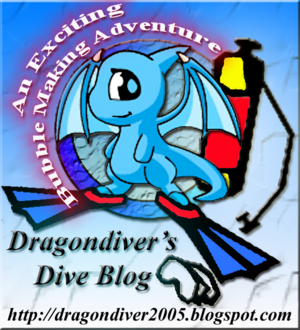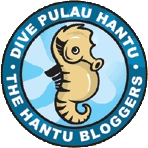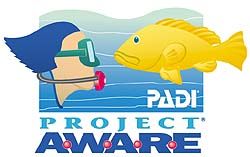North Sulawesi, Manado - Part 5 : Relishing Bunaken's Marine diversity once more
Manado Dive Travel - 11 to 15 November 2006
Partie Cinq de Six
Jour Quatre : Tuesday, 14 November 2006
Bunaken Marine Diversity - Enjoying A Good Mix of Big and Small




Embracing the wonders of Bunaken....
It was to be our last day of undersea adventures in Manado. We could only do a maximum of 3 dives before fulfilling a minimum of 24 hours before our flight next day.
We had a bit of discussion about where to go and what to see on this last day. The majority(Michelle and Alex) voted against macro so we were off to see pelagics in the deep blue.
I had no violent objection as I thought of watching some big deep sea fishes as well.
We reviewed the sites around Bunaken Marine Park and found some famous sites possible for pelagic encounters with the Napolean Wrasse, Barracudas, Sharks and Jacks. It's hard to decide which sites we wanted to do, so we asked the expert(Noldi) for opnions and off we set out, placing absolute trust in him that we'll get to see what we asked for!
We were again blessed with good and fair weather on the last day out at sea. We were enjoying each and every moment, tanning under the warm rays and riding over the cool waters.
The Hues of the Deep Blue
Dive Site: Tanjung Kopi
Location: Manado Tua
Visibilty: 35 m
Temperature: 27°C
Maximum Depth: 39.7 m
This site features dramatic walls and deep recesses of up to a few hundreds metres. Tanjung Kopi can be translated to mean Coffee Point but the reason for this name remains a mystery. It lies on the north of Manado Tua which is dormant but not totally extinct as volcano activity is still reported. This is the place where deep underwater exploration was carried out to study the Coelacanth, a deep sea living fossil of a prehistoric fish thought to have been extinct long ago but was recently discovered thriving healthily here.
The dive site's main attraction is a sloping underwater plateau that descends from 5 to 30 metres, fringed with a vertical wall that drops off to over 80 metres. You can see the hardened lava flow, remnants of past eruptions of Manado Tua. This is a site for the experienced only as currents can be very strong. An experienced dive guide is essential for diving here, as entry at the correct point is critical. This is the ideal location in Bunaken to see the bigger fish species.
For people who love beautiful views of coral life, this site offers some of the best soft coral gardens at Manado Tua. The colourful corals, abundant reef fishes, big fish actions and the the fantastic visibility makes this site highly recomended. There's also opportunities for macro as shrimps, slugs and worms crawl among the hues of the blues here. One thing to mention in particular about this site is, it is overgrown with hydroids big and small, especially a long feathery purple species which looked really beautiful. I was not careful and accidentally brushed my right wrist against one of such long purple duster. I was ensnared with a horrendous wound that made me cried painfully underwater....
The grandeur of Manado Tua Island itself will leave you fascinated about how the magnificient
underwater topography, outlined by the larva flow, was formed eons ago.
Partie Cinq de Six
Jour Quatre : Tuesday, 14 November 2006
Bunaken Marine Diversity - Enjoying A Good Mix of Big and Small




Embracing the wonders of Bunaken....
It was to be our last day of undersea adventures in Manado. We could only do a maximum of 3 dives before fulfilling a minimum of 24 hours before our flight next day.
We had a bit of discussion about where to go and what to see on this last day. The majority(Michelle and Alex) voted against macro so we were off to see pelagics in the deep blue.
I had no violent objection as I thought of watching some big deep sea fishes as well.
We reviewed the sites around Bunaken Marine Park and found some famous sites possible for pelagic encounters with the Napolean Wrasse, Barracudas, Sharks and Jacks. It's hard to decide which sites we wanted to do, so we asked the expert(Noldi) for opnions and off we set out, placing absolute trust in him that we'll get to see what we asked for!
We were again blessed with good and fair weather on the last day out at sea. We were enjoying each and every moment, tanning under the warm rays and riding over the cool waters.
The Hues of the Deep Blue
Dive Site: Tanjung Kopi
Location: Manado Tua
Visibilty: 35 m
Temperature: 27°C
Maximum Depth: 39.7 m
This site features dramatic walls and deep recesses of up to a few hundreds metres. Tanjung Kopi can be translated to mean Coffee Point but the reason for this name remains a mystery. It lies on the north of Manado Tua which is dormant but not totally extinct as volcano activity is still reported. This is the place where deep underwater exploration was carried out to study the Coelacanth, a deep sea living fossil of a prehistoric fish thought to have been extinct long ago but was recently discovered thriving healthily here.
The dive site's main attraction is a sloping underwater plateau that descends from 5 to 30 metres, fringed with a vertical wall that drops off to over 80 metres. You can see the hardened lava flow, remnants of past eruptions of Manado Tua. This is a site for the experienced only as currents can be very strong. An experienced dive guide is essential for diving here, as entry at the correct point is critical. This is the ideal location in Bunaken to see the bigger fish species.
For people who love beautiful views of coral life, this site offers some of the best soft coral gardens at Manado Tua. The colourful corals, abundant reef fishes, big fish actions and the the fantastic visibility makes this site highly recomended. There's also opportunities for macro as shrimps, slugs and worms crawl among the hues of the blues here. One thing to mention in particular about this site is, it is overgrown with hydroids big and small, especially a long feathery purple species which looked really beautiful. I was not careful and accidentally brushed my right wrist against one of such long purple duster. I was ensnared with a horrendous wound that made me cried painfully underwater....
The grandeur of Manado Tua Island itself will leave you fascinated about how the magnificient
underwater topography, outlined by the larva flow, was formed eons ago.
 A small school of barracudas swimming in the current above us... the sunrays casted shadows of their unmistakable identity.
A small school of barracudas swimming in the current above us... the sunrays casted shadows of their unmistakable identity.A very impressive, torpedo shaped predator that cruised past me while I was on the plateau's edge. This is a pelagic species that hunts ocassionally along slopes and dropoffs on the outer reefs in deep waters. It has a steel- silver body marked with several wavy dark bars. It usually hunts alone or sometimes in small roving schools raiding the reefs. It is a predator built for speed with pointed head, large round eyes and a great falcate tail.
A typically reddish orange species that tend to spend its entire life on the same single host. It is usually found in current prone areas and tidal channels. They live exclusively on Sea Whips and gorgornians. Whip gobies tend to move and hide on the opposite side of their host away from view when obverved. An assistance from a dive buddy would be an added advantage to keep this elusive fish in the photographer's view.


Broadclub Cuttlefish (Sepia latimanus)
A spectacular and beautiful cuttlefish that can grow to a large size. It will readily allow interaction with divers without showing signs of fear. It can display a broad range of "emotions" by changing its textures and colours with speculative intelligence. If alarmed by sudden movements, it will raise its 2 fore tentacles as a sign of warning in its defensive mode. Variations in colours and skin textures are apparently endless.
This little shrimp live exclusively in association with sea stars. This specimen was found on the underside of a pincushion star(Culcita novaguineae). It is very small and commonly found in small groups on the same host. They are very shy and will dart to hide immediately if disturbed. Their colouration are highly variable and are always dependent on the colour of its sea star host.


Showing the typical oral tentacles at the front of the head, on either side of the mouth and the smaller rhinophores just above the eyes. At the back you can see the large parapodial flaps which have a black edge. These parapodia enclose the mantle cavity in which the fragile plate-like shell is found. A black ring outlines the hole (foramen) which leads to the cavity in which the shell is found. Probably the smallest species of Aplysia, reaching a maximium length of about 6cm. The 2 specimens above were found on the same hyroids and algae turf and they are 2 different colour variations of the same species. Often, this species spot a mottled brown or green body, but sometimes a more uniform colour. It usually has a dark border to the parapodia, and the large mantle foramen. The tips of tentacles are usually darker than the background colour.
Similar to Pseudoceros jebborum, but the latter has a thin, submarginal, black band while in P. paralaticlavus the black colour is dominating. The background colour is velvety black, with 3 large grey bands, one median and two lateral. Bright distinctive yellow edge. They are associated with colonial ascidians. This specimen above is a tiny juvenile of only about 2 cm.
Rendezvous with Ron's Big shots
Ron's point is a sloping sandy dive site that lies on the southern tip of to the west of Bunaken island. The sandy slope is littered with coral rubble and and the numerous boulders overgrown with soft corals. The terrain here gently slopes down to about 25m and drops off to the deep abyss. The dropoff walls featured dramatic gorgonians fans and a facade of multi-coloured corals that contrasted beautifully against the deep blue of the sea. Ron's point is situated at the mouth of the channel between Bunaken and Manado Tua islands, where currents meet and sweep through trecherously. The currents here can be strong and unpredictable and is a site recommended for the experienced.
On descend, we went down along the walls to a depth of 37.5 m and we did a gradual multi-level ascend to the shallower depths. The currents along the walls here were moving fast and we glided effortless along the drift. The currents changed directions serveral times and we did the same as well. There was a couple of times where we had to fight the down drift to maintain our multi-level ascend.
Expect lots of big fish actions here. There were the ocassional schools of fusiliers, snappers, unicornfish and batfish. The larger fishes moved with tremendous speed. I came across Spanish Mackerels, Giant Trevallies, Dog-tooth Tunas, a Giant Barracuda and a couple of Giant Sweetlips, all crusing the blue with their predatory instincts. Nodi saw a Black-tip Reef Shark which none of us were fortunate enough to share that vision. There were also interesting animals to see on the sandy reef - Groupers, Parrotfishes, Wrasses, Nudibranchs, Garden and Moray Eels as well as the Blue-Spotted Ray.
Alex and Michelle floated to the surface after they were dangerously close to deplete their air supply. I continued with Noldi foraging the flat shallows for critters, also at the same time doing my perpetual safety stop. Not much macro on this dive but the big stuffs would be sufficient to pump a bit of adrenalin through your body for an excitement. The downside would be the incapability of my camera to capture all those wide-angles...
Dive Site: Ron's Point
Location: Bunaken Island
Visibilty: 20 m
Temperature: 28°C
Maximum Depth: 37.5 m
A solitary Barracuda cruising the deep blue in search of prey. A giant torpedo that is powerfully built as a fearsome predator.
All batfish are fairly large, highly compressed, slow moving, with silvery shining body and a very calm demeanor. They sometimes occur in immense schools which are very impressive to behold. They all feed on algae, vegetable matter and variety of small invertebrates. Their juveniles are solitary and often hide among shallow reefs. Juveniles are often unbelievably different from their adult appearance in terms of shape and colour patterns. The species featured above are easily confused with very similar Platax teira and Platax boersii. Platax orbicularis is distinctly marked with two dark bars on the front of the body- one vertically across the eye and the other across the pectoral fin. It has small black flecks on the sides which are absent in other Platax species.
Garden eels are usually found in large aggregations on sandy or muddy flat bottoms close to the reefs, often in deep waters and in current prone areas. Their common name derives from their swaying in the current in big numbers, with only the head and the first part of their body emerging like many blades of grass from the substrate. They mainly feed on plankton brought by the current and seldom leave their burrows. This species is easily identified by the two sharp black spots on its finely speckled body. As with all garden eels, this elegant species lives in large colonies. They are partly submerged in the soft bottom and rising with the front part of the body to face the current and feed on the incoming drifting zooplankton. Garden eels are some of the most difficult and frustrating subjects to photograph as they are very sensitive to movements, always ready to slide down to hide in their burrows whenever a diver approach or exhale too loudly from a distance.
A very commonly observed species. The disc is rounded and is yellowish with several electric blue spots and bright yellow sinister-looking eyes. It also has one or two serrated spines midway along the tail length which is connected to a poison gland. It rarely digs under the sand and can be approached by a cautious diver.
A nudibranch of the family Aegiretidae. As with other species of Notodoris, the skin is toughened with tiny spicules, the upper surface has a few irregular pustules, and the small rhinophores are smooth and simple. The branched gills are situated midway along the body, partially hidden by three large lobes. The animal has a yellow background colour, with a pattern of diagonal and transverse black lines arranged in a network over the entire body. The gills and rhinophores are essentially yellow, but in juveniles, and some adults, there can be some black pigmentation. Notodoris minor can grow to 14 cm in length and feeds on calcareous sponges belonging to the family Leucettidae.
Next: Save the Best for the Last..... The Last dive - best Muck ever!
To be Continued...
Rendezvous with Ron's Big shots
Ron's point is a sloping sandy dive site that lies on the southern tip of to the west of Bunaken island. The sandy slope is littered with coral rubble and and the numerous boulders overgrown with soft corals. The terrain here gently slopes down to about 25m and drops off to the deep abyss. The dropoff walls featured dramatic gorgonians fans and a facade of multi-coloured corals that contrasted beautifully against the deep blue of the sea. Ron's point is situated at the mouth of the channel between Bunaken and Manado Tua islands, where currents meet and sweep through trecherously. The currents here can be strong and unpredictable and is a site recommended for the experienced.
On descend, we went down along the walls to a depth of 37.5 m and we did a gradual multi-level ascend to the shallower depths. The currents along the walls here were moving fast and we glided effortless along the drift. The currents changed directions serveral times and we did the same as well. There was a couple of times where we had to fight the down drift to maintain our multi-level ascend.
Expect lots of big fish actions here. There were the ocassional schools of fusiliers, snappers, unicornfish and batfish. The larger fishes moved with tremendous speed. I came across Spanish Mackerels, Giant Trevallies, Dog-tooth Tunas, a Giant Barracuda and a couple of Giant Sweetlips, all crusing the blue with their predatory instincts. Nodi saw a Black-tip Reef Shark which none of us were fortunate enough to share that vision. There were also interesting animals to see on the sandy reef - Groupers, Parrotfishes, Wrasses, Nudibranchs, Garden and Moray Eels as well as the Blue-Spotted Ray.
Alex and Michelle floated to the surface after they were dangerously close to deplete their air supply. I continued with Noldi foraging the flat shallows for critters, also at the same time doing my perpetual safety stop. Not much macro on this dive but the big stuffs would be sufficient to pump a bit of adrenalin through your body for an excitement. The downside would be the incapability of my camera to capture all those wide-angles...
Dive Site: Ron's Point
Location: Bunaken Island
Visibilty: 20 m
Temperature: 28°C
Maximum Depth: 37.5 m
A solitary Barracuda cruising the deep blue in search of prey. A giant torpedo that is powerfully built as a fearsome predator.
All batfish are fairly large, highly compressed, slow moving, with silvery shining body and a very calm demeanor. They sometimes occur in immense schools which are very impressive to behold. They all feed on algae, vegetable matter and variety of small invertebrates. Their juveniles are solitary and often hide among shallow reefs. Juveniles are often unbelievably different from their adult appearance in terms of shape and colour patterns. The species featured above are easily confused with very similar Platax teira and Platax boersii. Platax orbicularis is distinctly marked with two dark bars on the front of the body- one vertically across the eye and the other across the pectoral fin. It has small black flecks on the sides which are absent in other Platax species.
Garden eels are usually found in large aggregations on sandy or muddy flat bottoms close to the reefs, often in deep waters and in current prone areas. Their common name derives from their swaying in the current in big numbers, with only the head and the first part of their body emerging like many blades of grass from the substrate. They mainly feed on plankton brought by the current and seldom leave their burrows. This species is easily identified by the two sharp black spots on its finely speckled body. As with all garden eels, this elegant species lives in large colonies. They are partly submerged in the soft bottom and rising with the front part of the body to face the current and feed on the incoming drifting zooplankton. Garden eels are some of the most difficult and frustrating subjects to photograph as they are very sensitive to movements, always ready to slide down to hide in their burrows whenever a diver approach or exhale too loudly from a distance.
A very commonly observed species. The disc is rounded and is yellowish with several electric blue spots and bright yellow sinister-looking eyes. It also has one or two serrated spines midway along the tail length which is connected to a poison gland. It rarely digs under the sand and can be approached by a cautious diver.
A nudibranch of the family Aegiretidae. As with other species of Notodoris, the skin is toughened with tiny spicules, the upper surface has a few irregular pustules, and the small rhinophores are smooth and simple. The branched gills are situated midway along the body, partially hidden by three large lobes. The animal has a yellow background colour, with a pattern of diagonal and transverse black lines arranged in a network over the entire body. The gills and rhinophores are essentially yellow, but in juveniles, and some adults, there can be some black pigmentation. Notodoris minor can grow to 14 cm in length and feeds on calcareous sponges belonging to the family Leucettidae.
Next: Save the Best for the Last..... The Last dive - best Muck ever!
To be Continued...
Labels: Trip Report







































0 Bubbles Created:
Post a Comment
<< Home